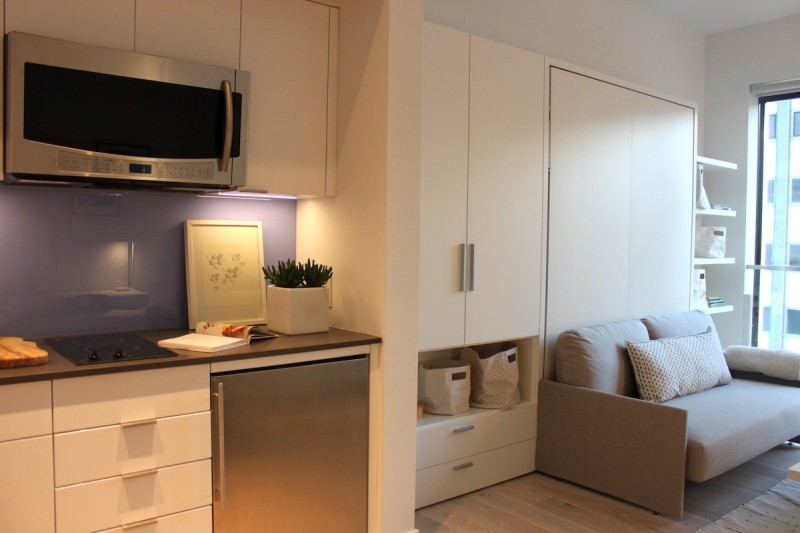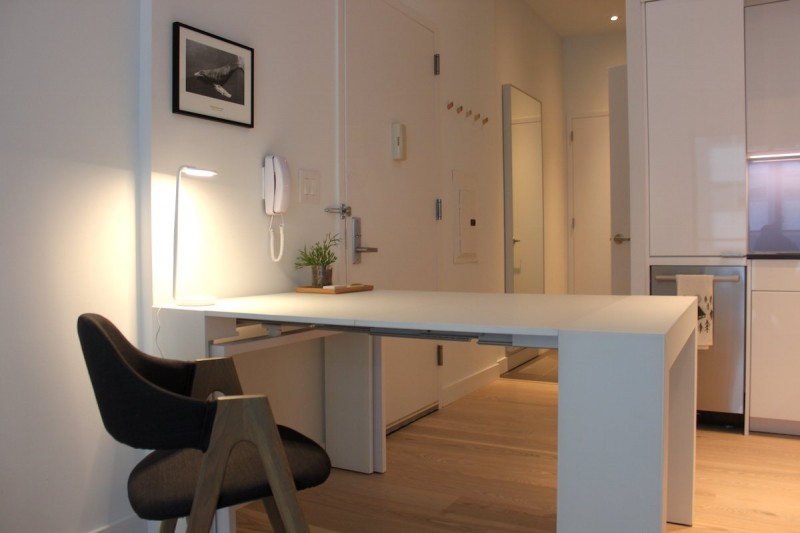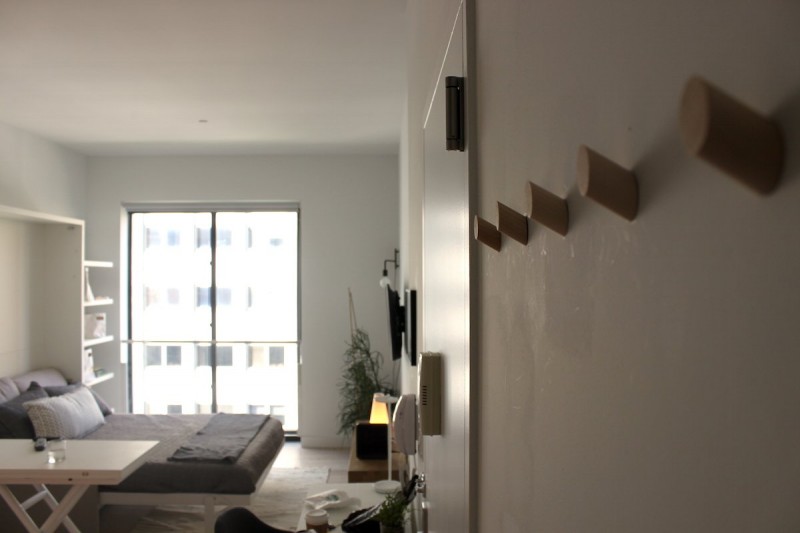New Yorkers are paying $3,000 a month to live in tiny apartments that are the size of one-car garages — here’s what they’re like inside

When you move to a major city, you usually expect that you’ll live in an expensive, shoebox-sized apartment.
A new set of apartments in Manhattan are even smaller than your average studio — but much better designed. The idea is that the minimalist, chic design makes ultra-tiny living possible.
Carmel Place houses Manhattan’s first micro-apartments, all ranging from 260 to 360 square feet. For comparison, the average Manhattan studio is twice that size, and a standard one-car garage is about 200 square feet.
To make the limited square footage more livable, Monadnock Development enlisted the help of the lifestyle design company Common and Screech Owl designer Jacqueline Schmidt. They meticulously designed 17 of the 55 units with space-saving furniture and accessories.
Unlike most tiny apartments in Manhattan, they’re designed from the ground-up for minimalist living, Schmidt tells Tech Insider.
To see for myself, I spent a night in one of Carmel Place’s 308-square-foot furnished apartments. Here’s what it was like.
Carmel Place is located in Kip’s Bay, a neighborhood on the lower east end of Manhattan near the East River.

The nine-story building features 55 units, and the first 36 tenants moved in June 1, Common co-founder Andrew Bledsoe tells Tech Insider.
About half of the building’s studios are furnished by Common. The service also includes WiFi, cable, and subscriptions to the events club Magnises and the butler service Hello Alfred.
Every week, a Hello Alfred employee will make the bed, change the linens, grocery shop, mail packages, replenish household staples, and drop off laundry and dry cleaning.
Depending on whether the apartments include Common’s amenities, monthly rent ranges from $2,450 to $3,000.

When I walked in, the apartment looked stunning. The majority of the furniture was white, which made the room seem a lot larger.
The room featured plenty of convertible furniture. At first, the two tables seemed small, but they could both extend to be larger in a matter of seconds.

Succulents populated the space. This makes a lot of sense for a micro-apartment, since they don’t require much light or maintenance.

The shelves by the couch (which folds out into a bed) had bags for easy storage. If I actually lived there and didn’t have time to clean up whatever was on the floor, I could just throw it in a bag.

Every kitchen appliance — the microwave, fridge, dishwasher, and electric stovetop — was miniature. There was also a toaster oven, but no actual oven (bummer).

I could imagine having a small get-together with a few friends, but I couldn’t entertain large parties or cook Thanksgiving dinner here. The apartment is definitely only designed for one.
The bathroom was spacious, though.

During the evening, the building hosted a rooftop party featuring a DJ and a bartender. As I made the rounds, it seemed to be half real estate brokers and developers (dressed in suits) and half residents attending.

One 33-year-old resident named Trey says he chose to live at Carmel Place, because it’s three blocks away from work. He doesn’t imagine himself getting married and doesn’t entertain friends much.

For him, the apartment is more of “a place to crash” — except more fashionable than what he’d likely find on Craigslist. Trey’s thoughts mirrored what several other residents said: they don’t actually plan to spend much time in the apartment.
After the party was over, I went downstairs and folded down my bed from the wall.

It only took about two minutes, but it would probably be cumbersome to do every day. If I lived there, the wall bed would likely stay down most days.
I then walked down the street, grabbed a chicken shawarma, propped up the adjustable table, and watched some TV.

Carmel Place isn’t the first set of tiny homes in NYC. Thousands of closet-sized apartments were built prior to the city’s 1987 zoning standards, which requires units to be at least 400 square feet. But Carmel Place will be the first micro-apartment development done in partnership with the city. Some 22 of its apartments were divvied up as part of the city’s affordable housing lottery, with eight going to veterans, Bledsoe says.
The city may do away with the square footage restrictions, but in the meantime, Carmel Place got a zoning waiver.
The development will test whether micro-apartments can be both comfortable and affordable for New Yorkers, Bledsoe says.

Other unfurnished studios in the neighborhood cost anywhere from $2,300 to $3,200 per month, but for twice the square footage. When you do the math, you’re paying about $10 per square foot of furnished space at Carmel Place.
Carmel Place apartments are a bit expensive for the area. But you’re not just paying for the square footage at Carmel Place.

You’re also paying for Schmidt’s design eye, Common’s amenities, the building’s gym, and the fact that everything’s new.

“We’re noticing that people are willing to trade off space for a better experience,” Bledsoe says.

In my adult life, I’ve never lived without roommates. I actually was a little lonely living for one day in that small apartment.
That’s not to say that the apartment isn’t live-able — If I could afford to shell out $2,500 a month, it’d be easy to live here. The beautiful room, complete with a butler service and curated furniture, felt more like a hotel than an apartment.
I’d be interested to see how a lived-in micro-apartment looks after a few weeks of wear, though. When you’re working with 300 square feet, every inch of floorspace counts.
Back to Press

